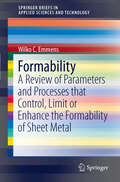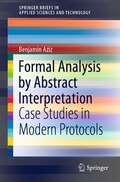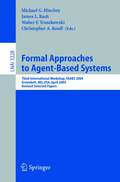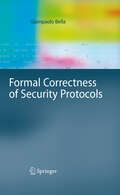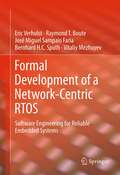- Table View
- List View
Forgotten Agricultural Heritage: Reconnecting food systems and sustainable development (Earthscan Food and Agriculture)
by Parviz Koohafkan Miguel A. AltieriContemporary agriculture is often criticized for its industrial scale, adverse effects on nutrition, rural employment and the environment, and its disconnectedness from nature and culture. Yet there are many examples of traditional smaller scale systems that have survived the test of time and provide more sustainable solutions while still maintaining food security in an era of climate change. This book provides a unique compilation of this forgotten agricultural heritage and is based on objective scientific evaluation and evidence of the value of these systems for present and future generations. The authors refer to many of these systems as Globally Important Agricultural Heritage Systems (GIAHS) and show how they are related to the concepts of heritage and the World Heritage Convention. They demonstrate how GIAHS based on family farms, traditional indigenous knowledge and agroecological principles can contribute to food and nutrition security and the maintenance of agro-biodiversity and environmental resilience, as well as sustain local cultures, economies and societies. Two substantial chapters are devoted to descriptions and assessments of some 50 examples of designated and potential GIAHS from around the world, including rice-fish culture in China, mountain terrace systems in Asia, coffee agroforestry in Latin America, irrigation systems and land and water management in Iran and India, pastoralism in East Africa, and the dehesa agrosilvopastoral system of Spain and Portugal. The book concludes by providing policy and technical solutions for sustainable agriculture and rural development through the enhancement of these systems.
Forgotten Agricultural Heritage: Reconnecting food systems and sustainable development (Earthscan Food and Agriculture)
by Parviz Koohafkan Miguel A. AltieriContemporary agriculture is often criticized for its industrial scale, adverse effects on nutrition, rural employment and the environment, and its disconnectedness from nature and culture. Yet there are many examples of traditional smaller scale systems that have survived the test of time and provide more sustainable solutions while still maintaining food security in an era of climate change. This book provides a unique compilation of this forgotten agricultural heritage and is based on objective scientific evaluation and evidence of the value of these systems for present and future generations. The authors refer to many of these systems as Globally Important Agricultural Heritage Systems (GIAHS) and show how they are related to the concepts of heritage and the World Heritage Convention. They demonstrate how GIAHS based on family farms, traditional indigenous knowledge and agroecological principles can contribute to food and nutrition security and the maintenance of agro-biodiversity and environmental resilience, as well as sustain local cultures, economies and societies. Two substantial chapters are devoted to descriptions and assessments of some 50 examples of designated and potential GIAHS from around the world, including rice-fish culture in China, mountain terrace systems in Asia, coffee agroforestry in Latin America, irrigation systems and land and water management in Iran and India, pastoralism in East Africa, and the dehesa agrosilvopastoral system of Spain and Portugal. The book concludes by providing policy and technical solutions for sustainable agriculture and rural development through the enhancement of these systems.
Forks, Phonographs, and Hot Air Balloons: A Field Guide to Inventive Thinking
by Robert J. WeberHow do inventions take shape? How did the inventors of the sewing needle, the hammer, or the wheel find their ideas? Are these creations the result of random events, or are hidden principles at work? Using everyday objects most of us take for granted--from forks and Velcro to safety pins and doorknobs--noted cognitive psychologist Robert Weber takes a fascinating look at how our world of inventions came into being, and how the mind's problem-solving abilities gave them the forms they have. As an archaeologist studies shards of pottery for clues about an ancient culture, Weber examines the many forms of inventions, from stone knives to genetically engineered mice, and finds a rich record of the work of many minds over time--a record of human creativity and problem-solving handed down through the centuries. He offers various methods for analyzing what mental paths might have been taken by these inventive minds. In the test for design, for example, he ponders how an item would work if various components were shuffled or constructed differently, revealing how the optimal shape of the invention was discovered. He challenges the reader to engage in thought experiments to explore how the horse-drawn cart, the waterscrew, or the fork might have taken shape over many years, through the efforts of successive inventors and adapters. In stripping these simple artifacts to the bone, Weber finds a hidden intelligence at work in everyday objects as well as recurrent heuristics (basic principles or rules of thumb) that are common among many of our most successful inventions--heuristics powerful enough to generate endless new ideas. Weber ranges across the work of Archimedes, Leonardo da Vinci, the Wright brothers, as well as grade-school children who have won national awards for their inventions, revealing that the same principles are at work in the discoveries of all of them. Basic principles of invention, he writes, govern how we think, solve, and manipulate ideas, whether mechanical or mental, real or mythological. Weber's playful, original, and insightful look at the inventions around us reveals a hidden intelligence in everything from screws to tea bags to synthesizers--an intelligence based on principles of creativity and problem-solving. His fascinating account sheds light on how the mind hones its most original thoughts and products, and provides a field guide for how we can tap into our own creativity.
Form der wissenschaftlichen Ausarbeitung: Studienarbeit, Diplomarbeit, Dissertation, Konferenzbeitrag (eXamen.press)
by Tilo GockelPraxisorientiert und ohne erhobenen Zeigefinger behandelt der Leitfaden alle wichtigen Themen rund um die wissenschaftliche Ausarbeitung: von der Recherche über die Verwaltung der Quellen, Rechtschreibung, Stil und Gliederung bis hin zur korrekten Zitierweise, Fragen des Urheberrechts, Formeln und Grafiken sowie dem Umgang mit Verlag und Druckerei. Eine Vorlage auf Basis des Textverarbeitungsprogramms LaTeX ist online frei erhältlich. Sie bietet eine solide Basis für eine wissenschaftliche Arbeit im Rahmen des Studiums oder für eine Dissertation.
Form der wissenschaftlichen Ausarbeitung: Studienarbeit, Diplomarbeit, Dissertation, Konferenzbeitrag (eXamen.press)
by Tilo GockelAbsolut praxisnah und ohne erhobenen Zeigefinger behandelt der Leitfaden Themen rund um die Erstellung einer wissenschaftlichen Ausarbeitung. Er gibt Antworten auf Fragen von der Recherche, Zitierweise, Gliederung, Einsatz von Software-Tools und Erstellung von Grafiken, Charts, Formeln, und Diagrammen über den Austausch mit Verlagen bzw. Druckereien bis hin zu Rechtschreibung und Stil. Das Buch dient als solide Basis für Seminararbeit oder Dissertation. Eine komfortable LaTeX-Vorlage ist online kostenfrei erhältlich.
Form, Structure and Mechanism
by Michael J. FrenchGood design is a crucial factor in both the performance of a product and its cost of manufacture. As such, the teaching of design skills is becoming an increasingly important aspect of engineering degree courses. Form, Structure and Mechanism, written for the engineering undergraduate studying a design course, draws on the engineering theory taught in the early part of the degree and shows how it can be applied to challenging and realistic design problems.
Form und Endziel einer allgemeinen Versorgung mit Elektrizität: Herausgegeben im Auftrage des Beratungsvereins „Elektrizität“ e. V.
by Ludwig AschoffDieser Buchtitel ist Teil des Digitalisierungsprojekts Springer Book Archives mit Publikationen, die seit den Anfängen des Verlags von 1842 erschienen sind. Der Verlag stellt mit diesem Archiv Quellen für die historische wie auch die disziplingeschichtliche Forschung zur Verfügung, die jeweils im historischen Kontext betrachtet werden müssen. Dieser Titel erschien in der Zeit vor 1945 und wird daher in seiner zeittypischen politisch-ideologischen Ausrichtung vom Verlag nicht beworben.
Formability: A Review of Parameters and Processes that Control, Limit or Enhance the Formability of Sheet Metal (SpringerBriefs in Applied Sciences and Technology)
by Wilko C. Emmens- Overview of materials and treatment aspects of manufacturability of sheet metal - Written by an industrial expert turned scientist - Concentrates on the formability of sheet metal, one of the fundamental form material is used in metalworking
Formability of Metallic Materials: Plastic Anisotropy, Formability Testing, Forming Limits (Engineering Materials)
by H.J. Bunge K. Pöhlandt A.E. Tekkaya D. BanabicAfter a brief introduction into crystal plasticity,the fun- damentals of crystallographic textures and plastic anisotro- py, a main topic of this book, are outlined. A large chapter is devoted to formability testing both for bulk metal and sheet metal forming. For the first time testing methods for plastic anisotropy of round bars and tubes are included. A profound survey is given of literature about yield criteria for anisotropic materials up to most recent developments and the calculation of forming limits of anisotropic sheet me- tal. Other chapters are concerned with properties of workpieces after metal forming as well as the fundamentals of the theory of plasticity and finite element simulation of metal forming processes. The book is completed by a collection of tables of international standards for formability testing and of flow curves of metals which are most commonly used in metal forming. It is addressed both to university and industrial readers.
Formal Analysis by Abstract Interpretation: Case Studies in Modern Protocols (SpringerBriefs in Applied Sciences and Technology)
by Benjamin AzizThe book provides a gentle introduction and definition of the denotational-based abstract interpretation method. The book demonstrates how the above method of formal analysis can be used, not only to address the security of systems, but other more general and interesting properties related to the testing, mutating and semantic ambiguity resolution of protocols. The book presents three case studies, all related to current complex protocols and standards used in industry, particularly in the context of IoT and Industry 4.0.
Formal Analysis of Future Energy Systems Using Interactive Theorem Proving (SpringerBriefs in Applied Sciences and Technology)
by Asad Ahmed Osman Hasan Falah Awwad Nabil BastakiThis book describes an accurate analysis technique for energy systems based on formal methods—computer-based mathematical logic techniques for the specification, validation, and verification of the systems. Correctness and accuracy of the financial, operational, and implementation analysis are of the paramount importance for the materialization of the future energy systems, such as smart grids, to achieve the objectives of cost-effectiveness, efficiency, and quality-of-service. In this regard, the book develops formal theories of microeconomics, asymptotic, and stability to support the formal analysis of generation and distribution cost, smart operations, and processing of energy in a smart grid. These formal theories are also employed to formally verify the cost and utility modeling for: Energy generation and distribution;Asymptotic bounds for online scheduling algorithms for plug-in electric vehicles; andStability of the power converters for wind turbines. The proposed approach results in mechanized proofs for the specification, validation, and verification of corresponding smart grid problems. The formal mathematical theories developed can be applied to the formal analysis of several other hardware and software systems as well, making this book of interest to researchers and practicing engineers in a variety of power electronic fields.
Formal and Informal Approaches to Food Policy (SpringerBriefs in Food, Health, and Nutrition)
by William Aspray George Royer Melissa G. OcepekFormal approaches are those taken by government bodies through laws, court decisions and actions of government regulatory bodies. Informal approaches are those taken by individuals, non profit organizations, industries working at self-regulation, etc. Because the formal means are tied to a particular legal system, this kind of approach is nation-specific and the book focuses on the United States. But many of the things the authors have to say about US food policy and the interactions between formal and informal approaches would also be of interest to policymakers and food industry professionals in other countries. Coverage includes the regulation of food advertising on children's television and the internet, regulation of school lunch programs and the influence of Eleanor Roosevelt and Michelle Obama.
A Formal Approach to Hardware Design (The Springer International Series in Engineering and Computer Science #253)
by Jørgen StaunstrupA Formal Approach to Hardware Design discusses designing computations to be realised by application specific hardware. It introduces a formal design approach based on a high-level design language called Synchronized Transitions. The models created using Synchronized Transitions enable the designer to perform different kinds of analysis and verification based on descriptions in a single language. It is, for example, possible to use exactly the same design description both for mechanically supported verification and synthesis. Synchronized Transitions is supported by a collection of public domain CAD tools. These tools can be used with the book in presenting a course on the subject. A Formal Approach to Hardware Design illustrates the benefits to be gained from adopting such techniques, but it does so without assuming prior knowledge of formal design methods. The book is thus not only an excellent reference, it is also suitable for use by students and practitioners.
Formal Approaches to Agent-Based Systems: Third International Workshop, FAABS 2004, Greenbelt, MD, April 26-27, 2004, Revised Selected Papers (Lecture Notes in Computer Science #3228)
by Michael G. Hinchey James L. Rash Walter F. Truszkowski Christopher A. RouffThe 3rd Workshop on Formal Approaches to Agent-Based Systems (FAABS-III) was held at the Greenbelt Marriott Hotel (near NASA Goddard Space Flight Center) in April 2004 in conjunction with the IEEE Computer Society. The first FAABS workshop was help in April 2000 and the second in October 2002. Interest in agent-based systems continues to grow and this is seen in the wide range of conferences and journals that are addressing the research in this area as well as the prototype and developmental systems that are coming into use. Our third workshop, FAABS-III, was held in April, 2004. This volume contains the revised papers and posters presented at that workshop. The Organizing Committee was fortunate in having significant support in the planning and organization of these events, and were privileged to have wor- renowned keynote speakers Prof. J Moore (FAABS-I), Prof. Sir Roger Penrose (FAABS-II), and Prof. John McCarthy (FAABS-III), who spoke on the topic of se- aware computing systems, auguring perhaps a greater interest in autonomic computing as part of future FAABS events. We are grateful to all who attended the workshop, presented papers or posters, and participated in panel sessions and both formal and informal discussions to make the workshop a great success. Our thanks go to the NASA Goddard Space Flight Center, Codes 588 and 581 (Software Engineering Laboratory) for their financial support and to the IEEE Computer Society (Technical Committee on Complexity in Computing) for their sponsorship and organizational assistance.
Formal Correctness of Security Protocols (Information Security and Cryptography)
by Giampaolo BellaThe author investigates proofs of correctness of realistic security protocols in a formal, intuitive setting. The protocols examined include Kerberos versions, smartcard protocols, non-repudiation protocols, and certified email protocols. The method of analysis turns out to be both powerful and flexible. This research advances significant extensions to the method of analysis, while the findings on the protocols analysed are novel and illuminating.
Formal Description Techniques and Protocol Specification, Testing and Verification: FORTE XI/PSTV XVIII’98 IFIP TC6 WG6.1 Joint International Conference on Formal Description Techniques for Distributed Systems and Communication Protocols (FORTE XI) and Protocol Specification, Testing and Verification (PSTV XVIII) 3–6 November 1998, Paris, France (IFIP Advances in Information and Communication Technology #6)
by Stan Budkowski Ana Cavalli Elie NajmFormal Description Techniques and Protocol Specification, Testing and Verification addresses formal description techniques (FDTs) applicable to distributed systems and communication protocols. It aims to present the state of the art in theory, application, tools and industrialization of FDTs. Among the important features presented are: FDT-based system and protocol engineering; FDT-application to distributed systems; Protocol engineering; Practical experience and case studies. Formal Description Techniques and Protocol Specification, Testing and Verification comprises the proceedings of the Joint International Conference on Formal Description Techniques for Distributed Systems and Communication Protocols and Protocol Specification, Testing and Verification, sponsored by the International Federation for Information Processing, held in November 1998, Paris, France. Formal Description Techniques and Protocol Specification, Testing and Verification is suitable as a secondary text for a graduate-level course on Distributed Systems or Communications, and as a reference for researchers and practitioners in industry.
Formal Description Techniques and Protocol Specification, Testing and Verification: FORTE X / PSTV XVII ’97 (IFIP Advances in Information and Communication Technology)
by Atsushi Togashi Tadanori Mizuno Norio Shiratori Teruo HigashinoFORTE/PSTV '97 addresses Formal Description Techniques (FDTs) applicable to Distributed Systems and Communication Protocols (such as Estelle, LOTOS, SDL, ASN.1, TTCN, Z, Automata, Process Algebra, Logic). The conference is a forum for presentation of the state-of-the-art in theory, application, tools and industrialization of FDTs, and provides an excellent orientation for newcomers.
Formal Description Techniques IX: Theory, application and tools (IFIP Advances in Information and Communication Technology)
by R. Gotzhein J. BrederekeThis book is the combined proceedings of the latest IFIP Formal Description Techniques (FDTs) and Protocol Specification, Testing and Verification (PSTV) series. It addresses FDTs applicable to communication protocols and distributed systems, with special emphasis on standardised FDTs. It features state-of-the-art in theory, application, tools and industrialisation of formal description.
Formal Description Techniques VII (IFIP Advances in Information and Communication Technology)
by D. Hogrefe S. LeueThis book presents the latest research in formal techniques for distributed systems, including material on theory, applications, tools and industrial usage of formal techniques.
Formal Description Techniques VIII (IFIP Advances in Information and Communication Technology)
by Gregor Von Bochmann Rachida Dssouli Omar RafiqThis volume contains the latest worldwide research results on formal description techniques applicable to telecommunications, covering their theoretical foundations, industrial applications and practical usage. The book presents the selected proceedings of the eighth International Conference on Formal Description Techniques, arranged by the International Federation for Information Processing and held in Montreal, Canada, October 1995.
Formal Development of a Network-Centric RTOS: Software Engineering for Reliable Embedded Systems
by Eric Verhulst Raymond T. Boute José Miguel Faria Bernhard H.C. Sputh Vitaliy MezhuyevMany systems, devices and appliances used routinely in everyday life, ranging from cell phones to cars, contain significant amounts of software that is not directly visible to the user and is therefore called "embedded". For coordinating the various software components and allowing them to communicate with each other, support software is needed, called an operating system (OS). Because embedded software must function in real time (RT), a RTOS is needed. This book describes a formally developed, network-centric Real-Time Operating System, OpenComRTOS. One of the first in its kind, OpenComRTOS was originally developed to verify the usefulness of formal methods in the context of embedded software engineering. Using the formal methods described in this book produces results that are more reliable while delivering higher performance. The result is a unique real-time concurrent programming system that supports heterogeneous systems with just 5 Kbytes/node. It is compatible with safety related engineering standards, such as IEC61508.
Formal Equivalence Checking and Design Debugging (Frontiers in Electronic Testing #12)
by Shi-Yu Huang Kwang-Ting (Tim) ChengFormal Equivalence Checking and Design Debugging covers two major topics in design verification: logic equivalence checking and design debugging. The first part of the book reviews the design problems that require logic equivalence checking and describes the underlying technologies that are used to solve them. Some novel approaches to the problems of verifying design revisions after intensive sequential transformations such as retiming are described in detail. The second part of the book gives a thorough survey of previous and recent literature on design error diagnosis and design error correction. This part also provides an in-depth analysis of the algorithms used in two logic debugging software programs, ErrorTracer and AutoFix, developed by the authors. From the Foreword: `With the adoption of the static sign-off approach to verifying circuit implementations the application-specific integrated circuit (ASIC) industry will experience the first radical methodological revolution since the adoption of logic synthesis. Equivalence checking is one of the two critical elements of this methodological revolution. This book is timely for either the designer seeking to better understand the mechanics of equivalence checking or for the CAD researcher who wishes to investigate well-motivated research problems such as equivalence checking of retimed designs or error diagnosis in sequential circuits.' Kurt Keutzer, University of California, Berkeley
Formal Languages and Applications (Studies in Fuzziness and Soft Computing #148)
by Carlos Martin-Vide Victor Mitrana Gheorghe P 259 UnFormal Languages and Applications provides a comprehensive study-aid and self-tutorial for graduates students and researchers. The main results and techniques are presented in an readily accessible manner and accompanied by many references and directions for further research. This carefully edited monograph is intended to be the gateway to formal language theory and its applications, so it is very useful as a review and reference source of information in formal language theory.
Formal Languages, Automata and Numeration Systems 2: Applications to Recognizability and Decidability
by Michel RigoThe interplay between words, computability, algebra and arithmetic has now proved its relevance and fruitfulness. Indeed, the cross-fertilization between formal logic and finite automata (such as that initiated by J.R. Büchi) or between combinatorics on words and number theory has paved the way to recent dramatic developments, for example, the transcendence results for the real numbers having a “simple” binary expansion, by B. Adamczewski and Y. Bugeaud. This book is at the heart of this interplay through a unified exposition. Objects are considered with a perspective that comes both from theoretical computer science and mathematics. Theoretical computer science offers here topics such as decision problems and recognizability issues, whereas mathematics offers concepts such as discrete dynamical systems. The main goal is to give a quick access, for students and researchers in mathematics or computer science, to actual research topics at the intersection between automata and formal language theory, number theory and combinatorics on words. The second of two volumes on this subject, this book covers regular languages, numeration systems, formal methods applied to decidability issues about infinite words and sets of numbers.
Formal Languages, Automata and Numeration Systems 2: Applications to Recognizability and Decidability
by Michel RigoThe interplay between words, computability, algebra and arithmetic has now proved its relevance and fruitfulness. Indeed, the cross-fertilization between formal logic and finite automata (such as that initiated by J.R. Büchi) or between combinatorics on words and number theory has paved the way to recent dramatic developments, for example, the transcendence results for the real numbers having a “simple” binary expansion, by B. Adamczewski and Y. Bugeaud. This book is at the heart of this interplay through a unified exposition. Objects are considered with a perspective that comes both from theoretical computer science and mathematics. Theoretical computer science offers here topics such as decision problems and recognizability issues, whereas mathematics offers concepts such as discrete dynamical systems. The main goal is to give a quick access, for students and researchers in mathematics or computer science, to actual research topics at the intersection between automata and formal language theory, number theory and combinatorics on words. The second of two volumes on this subject, this book covers regular languages, numeration systems, formal methods applied to decidability issues about infinite words and sets of numbers.






